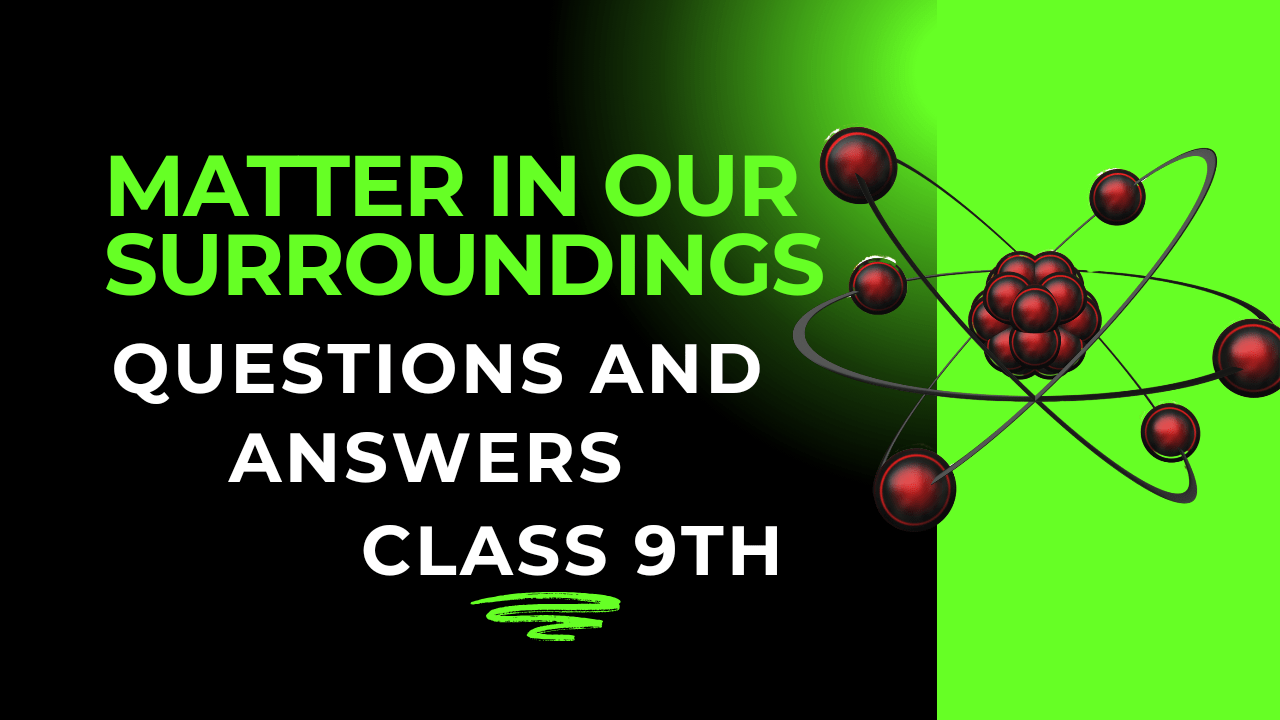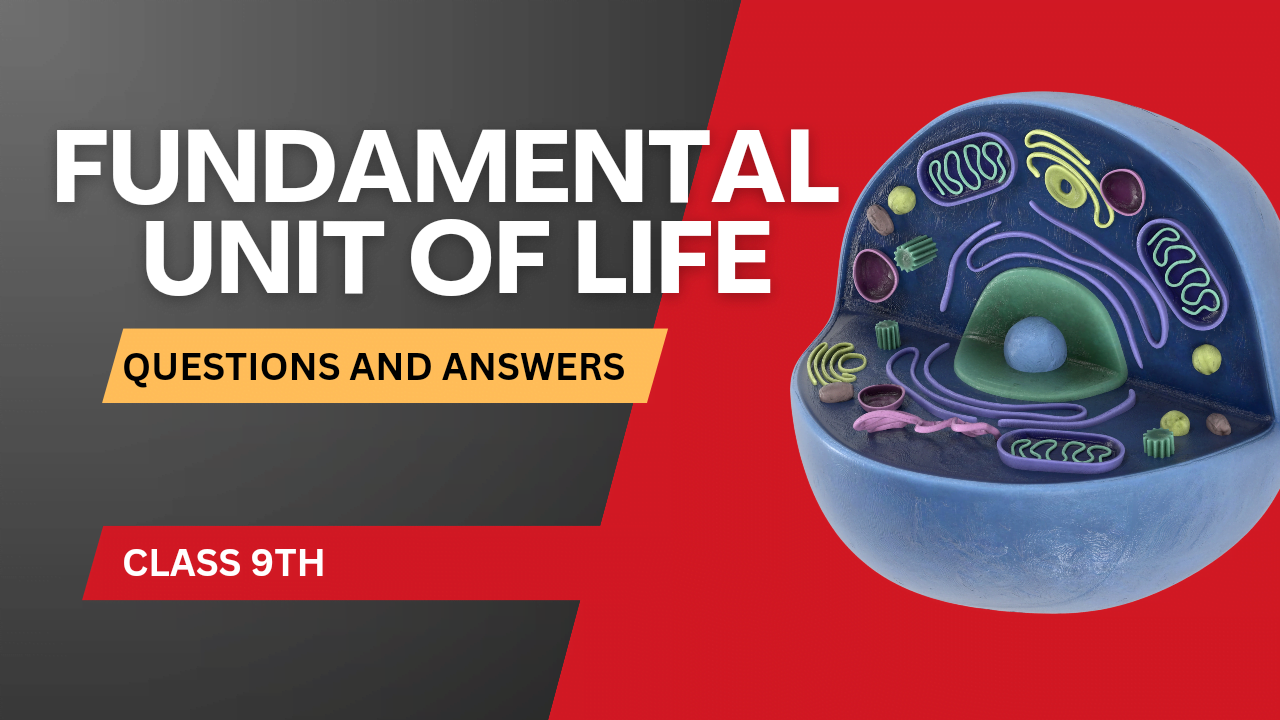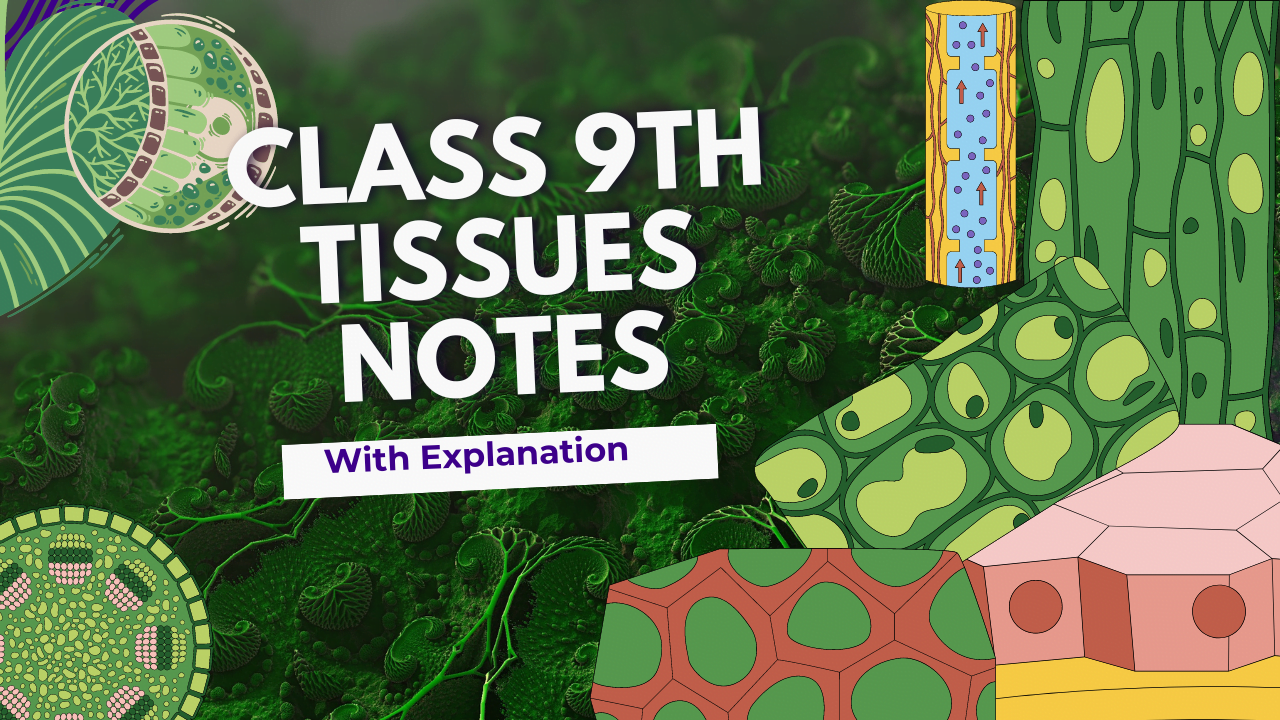NCERT Solutions Atoms and Molecules Class 9th Science
Q&A: Atoms and Molecules
1. In a reaction, 5.3 g of sodium carbonate reacted with 6 g of acetic acid. The products were 2.2 g of carbon dioxide, 0.9 g of water, and 8.2 g of sodium acetate. Show that these observations are in agreement with the law of conservation of mass.
Reaction: Sodium carbonate + Acetic acid → Sodium acetate + Carbon dioxide + Water
Answer: According to the law of conservation of mass, the mass of reactants must equal the mass of products.
Mass of reactants = 5.3 g (sodium carbonate) + 6.0 g (acetic acid) = 11.3 g.
Mass of products = 2.2 g (carbon dioxide) + 0.9 g (water) + 8.2 g (sodium acetate) = 11.3 g.
Hence, the mass of reactants is equal to the mass of the products, confirming the law of conservation of mass.
Mass of reactants = 5.3 g (sodium carbonate) + 6.0 g (acetic acid) = 11.3 g.
Mass of products = 2.2 g (carbon dioxide) + 0.9 g (water) + 8.2 g (sodium acetate) = 11.3 g.
Hence, the mass of reactants is equal to the mass of the products, confirming the law of conservation of mass.
2. Hydrogen and oxygen combine in the ratio of 1:8 by mass to form water. What mass of oxygen gas would be required to react completely with 3 g of hydrogen gas?
Answer: The ratio of hydrogen to oxygen in water is 1:8. This means 8 g of oxygen reacts with 1 g of hydrogen.
To react with 3 g of hydrogen:
Required mass of oxygen = 3 g × 8 = 24 g.
Therefore, 24 g of oxygen would be required to react completely with 3 g of hydrogen.
To react with 3 g of hydrogen:
Required mass of oxygen = 3 g × 8 = 24 g.
Therefore, 24 g of oxygen would be required to react completely with 3 g of hydrogen.
3. Which postulate of Dalton’s atomic theory is the result of the law of conservation of mass?
Answer: The postulate that “Atoms can neither be created nor destroyed in a chemical reaction” is a direct consequence of the law of conservation of mass.
4. Which postulate of Dalton’s atomic theory can explain the law of definite proportions?
Answer: The postulate that “Atoms of different elements combine in simple whole number ratios to form compounds” explains the law of definite proportions.
5. Define the atomic mass unit.
Answer: One atomic mass unit (u) is defined as 1/12th of the mass of a carbon-12 atom. Its value is approximately 1.66 × 10⁻²⁷ kg.
6. Why is it not possible to see an atom with naked eyes?
Answer: Atoms are extremely small, with sizes typically in the range of 0.1 to 0.5 nanometers (1 nm = 10⁻⁹ meters). This size is far smaller than the wavelength of visible light, making it impossible to see atoms with the naked eye.
7. Write down the formulae of:
- (i) Sodium oxide
- (ii) Aluminium chloride
- (iii) Sodium sulphide
- (iv) Magnesium hydroxide
Answer:
- (i) Sodium oxide: Na₂O
- (ii) Aluminium chloride: AlCl₃
- (iii) Sodium sulphide: Na₂S
- (iv) Magnesium hydroxide: Mg(OH)₂
8. Write down the names of compounds represented by the following formulae:
- (i) Al₂(SO₄)₃
- (ii) CaCl₂
- (iii) K₂SO₄
- (iv) KNO₃
- (v) CaCO₃
Answer:
- (i) Al₂(SO₄)₃: Aluminium sulphate
- (ii) CaCl₂: Calcium chloride
- (iii) K₂SO₄: Potassium sulphate
- (iv) KNO₃: Potassium nitrate
- (v) CaCO₃: Calcium carbonate
9. What is meant by the term chemical formula?
Answer: A chemical formula is a symbolic representation of a compound or molecule, showing the types and number of atoms of each element in the compound. For example, H₂O represents water, with 2 atoms of hydrogen and 1 atom of oxygen.
10. How many atoms are present in:
- (i) H₂S molecule
- (ii) PO₄³⁻ ion
Answer:
- (i) H₂S molecule contains 3 atoms (2 hydrogen atoms and 1 sulfur atom).
- (ii) PO₄³⁻ ion contains 5 atoms (1 phosphorus atom and 4 oxygen atoms).
11. Calculate the molecular masses of H₂, O₂, Cl₂, CO₂, CH₄, C₂H₆, C₂H₄, NH₃, CH₃OH.
Answer:
- H₂: 2 × 1 = 2 u
- O₂: 2 × 16 = 32 u
- Cl₂: 2 × 35.5 = 71 u
- CO₂: 12 + 2 × 16 = 44 u
- CH₄: 12 + 4 × 1 = 16 u
- C₂H₆: 2 × 12 + 6 × 1 = 30 u
- C₂H₄: 2 × 12 + 4 × 1 = 28 u
- NH₃: 14 + 3 × 1 = 17 u
- CH₃OH: 12 + 4 × 1 + 16 = 32 u
Exercise Questions and Answers
1. A 0.24 g sample of a compound of oxygen and boron was found by analysis to contain 0.096 g of boron and 0.144 g of oxygen. Calculate the percentage composition of the compound by weight.
Answer:
Mass of boron = 0.096 g
Mass of oxygen = 0.144 g
Total mass of the compound = 0.24 g
Percentage of boron = (0.096 / 0.24) × 100 = 40%
Percentage of oxygen = (0.144 / 0.24) × 100 = 60%
Therefore, the percentage composition of the compound by weight is 40% boron and 60% oxygen.
Mass of boron = 0.096 g
Mass of oxygen = 0.144 g
Total mass of the compound = 0.24 g
Percentage of boron = (0.096 / 0.24) × 100 = 40%
Percentage of oxygen = (0.144 / 0.24) × 100 = 60%
Therefore, the percentage composition of the compound by weight is 40% boron and 60% oxygen.
2. When 3.0 g of carbon is burnt in 8.00 g of oxygen, 11.00 g of carbon dioxide is produced. What mass of carbon dioxide will be formed when 3.00 g of carbon is burnt in 50.00 g of oxygen? Which law of chemical combination will govern your answer?
Answer:
According to the **law of constant proportions**, carbon dioxide will always be formed in the same fixed ratio of carbon to oxygen. In this case, 3.00 g of carbon requires exactly 8.00 g of oxygen to form 11.00 g of carbon dioxide. Since only 3.00 g of carbon is available, the same 11.00 g of carbon dioxide will be produced regardless of the excess oxygen (50.00 g).
The law of chemical combination that governs this reaction is the **Law of Constant Proportions**.
According to the **law of constant proportions**, carbon dioxide will always be formed in the same fixed ratio of carbon to oxygen. In this case, 3.00 g of carbon requires exactly 8.00 g of oxygen to form 11.00 g of carbon dioxide. Since only 3.00 g of carbon is available, the same 11.00 g of carbon dioxide will be produced regardless of the excess oxygen (50.00 g).
The law of chemical combination that governs this reaction is the **Law of Constant Proportions**.
3. What are polyatomic ions? Give examples.
Answer:
Polyatomic ions are ions that consist of two or more atoms covalently bonded together, which function as a single ion. These ions carry a charge due to the loss or gain of electrons.
**Examples:**
– Ammonium ion (NH₄⁺)
– Sulphate ion (SO₄²⁻)
– Nitrate ion (NO₃⁻)
– Phosphate ion (PO₄³⁻)
Polyatomic ions are ions that consist of two or more atoms covalently bonded together, which function as a single ion. These ions carry a charge due to the loss or gain of electrons.
**Examples:**
– Ammonium ion (NH₄⁺)
– Sulphate ion (SO₄²⁻)
– Nitrate ion (NO₃⁻)
– Phosphate ion (PO₄³⁻)
4. Write the chemical formulae of the following:
- (a) Magnesium chloride
- (b) Calcium oxide
- (c) Copper nitrate
- (d) Aluminium chloride
- (e) Calcium carbonate
Answer:
- (a) Magnesium chloride: MgCl₂
- (b) Calcium oxide: CaO
- (c) Copper nitrate: Cu(NO₃)₂
- (d) Aluminium chloride: AlCl₃
- (e) Calcium carbonate: CaCO₃
5. Give the names of the elements present in the following compounds:
- (a) Quick lime
- (b) Hydrogen bromide
- (c) Baking powder
- (d) Potassium sulphate
Answer:
- (a) Quick lime: Calcium (Ca), Oxygen (O)
- (b) Hydrogen bromide: Hydrogen (H), Bromine (Br)
- (c) Baking powder: Sodium (Na), Hydrogen (H), Carbon (C), Oxygen (O)
- (d) Potassium sulphate: Potassium (K), Sulphur (S), Oxygen (O)
6. Calculate the molar mass of the following substances:
- (a) Ethyne, C₂H₂
- (b) Sulphur molecule, S₈
- (c) Phosphorus molecule, P₄ (Atomic mass of phosphorus = 31)
- (d) Hydrochloric acid, HCl
- (e) Nitric acid, HNO₃
Answer:
- (a) Ethyne, C₂H₂: (2 × 12) + (2 × 1) = 24 + 2 = 26 g/mol
- (b) Sulphur molecule, S₈: 8 × 32 = 256 g/mol
- (c) Phosphorus molecule, P₄: 4 × 31 = 124 g/mol
- (d) Hydrochloric acid, HCl: 1 + 35.5 = 36.5 g/mol
- (e) Nitric acid, HNO₃: 1 + 14 + (3 × 16) = 1 + 14 + 48 = 63 g/mol
FAQs: Atoms and Molecules
1. What is the Law of Conservation of Mass?
Answer: The Law of Conservation of Mass states that in a chemical reaction, the total mass of the reactants is always equal to the total mass of the products.
2. What is the Law of Constant Proportions?
Answer: The Law of Constant Proportions states that a chemical compound always contains the same elements in a fixed proportion by mass.
3. What is an atom?
Answer: An atom is the smallest unit of an element that retains the properties of that element. It consists of protons, neutrons, and electrons.
4. What is atomic mass?
Answer: Atomic mass is the mass of an atom, typically measured in atomic mass units (amu). It is approximately equal to the total number of protons and neutrons in the atom.
5. What is the atomic mass unit (amu)?
Answer: An atomic mass unit (amu) is defined as 1/12th the mass of a carbon-12 atom.
6. How is molecular mass calculated?
Answer: Molecular mass is calculated by summing the atomic masses of all the atoms in a molecule.
7. What is a polyatomic ion?
Answer: A polyatomic ion is an ion composed of two or more atoms covalently bonded together, which act as a single charged entity.
8. What is the chemical formula of water?
Answer: The chemical formula of water is H₂O, indicating that it contains two hydrogen atoms and one oxygen atom.
9. What is the difference between a molecule of an element and a molecule of a compound?
Answer: A molecule of an element consists of two or more atoms of the same element bonded together, while a molecule of a compound consists of atoms of different elements chemically combined.
10. What is a chemical formula?
Answer: A chemical formula is a symbolic representation of a molecule or compound, showing the elements involved and the number of atoms of each.
11. What is a cation?
Answer: A cation is a positively charged ion that is formed when an atom loses one or more electrons.
12. What is an anion?
Answer: An anion is a negatively charged ion that is formed when an atom gains one or more electrons.
13. What is the molecular mass of carbon dioxide (CO₂)?
Answer: The molecular mass of carbon dioxide is 44 u (12 u for carbon + 2 × 16 u for oxygen).
14. What is the molar mass of ethyne (C₂H₂)?
Answer: The molar mass of ethyne (C₂H₂) is 26 g/mol.
15. Why can’t we see atoms with the naked eye?
Answer: Atoms are too small to be seen with the naked eye because their size is on the order of 0.1 to 0.5 nanometers, which is much smaller than the wavelength of visible light.
16. What is the chemical formula of aluminium chloride?
Answer: The chemical formula of aluminium chloride is AlCl₃.
17. What is the formula unit mass of sodium chloride (NaCl)?
Answer: The formula unit mass of sodium chloride is 58.5 u (23 u for Na + 35.5 u for Cl).
18. What is the molecular formula of methane (CH₄)?
Answer: The molecular formula of methane is CH₄, indicating that it contains one carbon atom and four hydrogen atoms.
19. What is meant by molar mass?
Answer: Molar mass is the mass of one mole of a substance, usually expressed in grams per mole (g/mol).
20. What is the molecular mass of chlorine (Cl₂)?
Answer: The molecular mass of chlorine (Cl₂) is 71 u (2 × 35.5 u).



